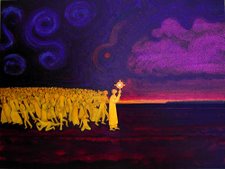By John F. Kavanaugh
The Case Against Perfection
By Michael J. Sandel
Belknap Press. 176p $18.95 (hardcover)
In his first essay, “The Ethics of Enhancement,” Sandel, professor of government at Harvard University, raises the question whether “curing” is different from “improving.” Do plastic surgery and Botox injections heal us or improve us? And if there is little difference, why do they seem acceptable, while muscle enhancement through steroids or blood doping is not? If growth hormones are permitted for children whose projected height is under 5 feet, why are they not acceptable for a possible 6-footer who wants to be a power forward? If reproductive autonomy is so important, why should it be prohibited for parents who want sex selection? He applies these questions more specifically to athletic enhancement, both low-tech assistance by better shoes and golf clubs, through Lasik surgery on to blood transfusions and hormone injections.
While discussing athletes, Sandel surfaces the theme that will mark his later discussion of “designer children” and his final chapter, called “Mastery and Gift.”
To acknowledge the giftedness of life is to recognize that our talents and powers are not wholly our own doing, nor even fully ours…. It is also to recognize that not everything in the world is open to any use we may desire or devise. An appreciation of the giftedness of life constrains the Promethean project and conduces to a certain humility.Thus, in discussing children, Sandel warns that they must be appreciated and accepted as gifts, not as objects to be manipulated for utilitarian or egoistic goals. He suggests that there is the danger of radical pride in trying to design or control. Concurring with William May, he holds that the “transforming love” of guiding, forming and enhancing a child must be balanced with “accepting love” that embraces children for their own intrinsic, not performative, goodness. While Sandel offers no hard and fast line of difference between (a) specialized training and the best schools, (b) growth hormones and orthodontics and (c) eugenics (a “presumably bad thing”), the drive to mastery and control could extinguish our appreciation of life as a gift.
The dangers of reproductive mastery are horrifically sketched in the book’s best chapter, a treatment of the “old” eugenics and the “new.” The old eugenics of forced sterilization in the United States and racial cleansing in the Third Reich, having been replaced by a seemingly more benign combination of market-based and liberal eugenics, still haunts our contemporary consciousness. Insistence on atomistic autonomy in reproduction and fixation on desired traits are a flight from the contingency and connectedness of our common humanity and a refusal to accept our existence as a gift. These are Sandel’s ideas most worthy of development and elaboration, perhaps in concert with his interlocutors, William May, Leon Kass, Charles Taylor and Jurgen Habermas.
As for myself, I would want to engage Sandel over his epilogue, the longest section of the book, titled “Embryo Ethics: The Stem Cell Debate.” This serious and insightful attempt to prove that an individual human life, and surely human personhood, is incorrectly attributed to early stage embryos, should be read by anyone who holds the conception criterion for the beginning of an individual human being. His arguments, while not being the traditional ones that are made concerning undifferentiated cells, twinning and the high number of spontaneous abortions, are telling. Our collecting of “spare” embryos, our apparent acceptance of in vitro fertilization, our lack of mourning for all the supposed tiny persons lost, President Bush’s eager willingness to say he is not banning the use of private funds for embryonic stem cell research all indicate that we really do not believe we are dealing with persons. This is indeed a powerful critique of the present confusion. But it does not address what exactly a human being is. Surely, as Sandel says, an acorn is not a full-blown oak. Neither is it a sapling. The acorn, however, is the start of a tree’s existence. An embryo, similarly, is neither a grandmother nor a toddler; but every piece of genetic evidence we have reveals that at conception we have the beginning of a unique human career (or two, if it is so programmed from the beginning to twin).
As you read this book, you might imagine yourself sitting in on one of Sandel’s classes of a thousand Harvard students. It is said that he can be mesmerizing with his probing questions and tricky sample cases. Another thing you might imagine is sitting with him at a meeting of the President’s Council on Bioethics, engaging the likes of William Hurlbut and Leon Kass—both strongly disagreeing with him at times, but hearing what he has to say and being honestly heard in return.
The Case Against Perfection, consequently, is open to a very wide audience indeed. It will introduce the novice to some of the knotty problems in genetic therapy and enhancement. It will propose thoughtful challenges to the college undergraduate. As for scholars, it will unsettle those who may have too easily or ideologically arrived at unwarranted conclusions. And it will challenge those of us who disagree with him on the status of the human embryo to provide our most cogent and well-evidenced arguments.



No comments:
Post a Comment